Noah’s Flood
Gertoux, Gérard
Gérard Gertoux (1955- ) is a French academic who is best known for his book The Name of God YeHoWaH(a)(b). However, most of his prodigious output is concerned with ancient chronology. Many of the subjects he discusses (c) are touched on in Atlantipedia – The Deluge, Exodus, The Trojan War, Carthage, The Hyksos, all of which are available, in English, on the Academia.edu website
(c) are touched on in Atlantipedia – The Deluge, Exodus, The Trojan War, Carthage, The Hyksos, all of which are available, in English, on the Academia.edu website
(b) THE NAME OF GOD YeHoWaH. ITS STORY, by Gérard Gertoux (lifes-purpose.info)
Harris, Stuart L.
Stuart L. Harris is an American researcher, self-described as an linguist, historian and archaeologist.  He has contributed over eighty papers to the Migration & Diffusion website(a) and dozens to the Academia.edu site(b). He has touched on a wide variety of subjects; from Comet Encke to Glozel and Newgrange to Noah’s Flood. Although I am not a linguist, I think that that Harris’ penchant for ‘finding’ evidence of the Finnish language in locations as far apart as Dacia, Gaul, Teotihuacan and Hawaii is highly questionable, but I shall leave it to others, more skilled than I, to comment further.
He has contributed over eighty papers to the Migration & Diffusion website(a) and dozens to the Academia.edu site(b). He has touched on a wide variety of subjects; from Comet Encke to Glozel and Newgrange to Noah’s Flood. Although I am not a linguist, I think that that Harris’ penchant for ‘finding’ evidence of the Finnish language in locations as far apart as Dacia, Gaul, Teotihuacan and Hawaii is highly questionable, but I shall leave it to others, more skilled than I, to comment further.
Inspired by Felice Vinci, Harris has promoted the idea of Troy in Finland, but until lately he had not directly addressed the question of Atlantis, but in recent private correspondence with me, he has claimed that Plato’s lost island had been situated in the vicinity of Rockall and destroyed around 9577 BC. He later published these ideas in a number of papers on the Academia.edu website(c-f) in which he proposed that a close encounter with Nibiru (Marduk) that resulted in a number of its satellites impacting the Earth, causing devastation which included the demise of Atlantis. He also equated Nibiru with Marduk. The article contains a lot of wild speculations including the suggestion that Nibiru on a return to Earth in 9417 BC, lost another of its satellites, which became our Moon!
(a) https://www.migration-diffusion.info/article.php?authorid=113
(b) https://independent.academia.edu/StuartHarris3
Booth & Fitch (N)
Basil Booth & Frank Fitch are two earth scientists who co-authored Earthshock[1295]. They reviewed the catastrophic past of our planet and its lessons for the future. They briefly touched on the subject of Atlantis suggesting that “it is possible that the legends of Atlantis and Noah’s Flood may arise from folk memories of ancient tsunamis”[p.102] and that the tsunami associated with the eruption of Thera that devasted the Minoan civilisation may have given rise to the legend of Atlantis[p.150].
Ryan & Pitman
William Ryan & Walter Pitman published evidence, in 1997, that extensive flooding of the Black Sea occurred through the Bosphorus around 5600 BC. Controversy still surrounds various aspects of their
theory, some even claiming that the Black Sea broke into the Aegean, an idea that may be partially true(d)(e).
Nevertheless, their conclusions were challenged in a paper(c) by Yanko-hombach, Gilbert and Dolukhanov, who offered evidence that the flooding of the Black Sea was not the rapid event claimed, but was spread over millennia, initially in the form of freshwater from the Caspian Sea via the Manych Spillway(d) as the glaciers retreated and later with seawater from the Mediterranean. The same paper concludes with the following; “The public perception that ‘Noah’s Flood’ happened there is not supported by any scientific evidence.”
Ryan & Pitman later published their theories in book form as Noah’s Flood[0025] and was understandably seized upon by many as proof of the veracity of the Bible. In fact a year before Ryan & Pitman launched their book, René & Denise Capart published l homme et les déluges[1062], in which they linked the Black Sea with the Deluge of Noah. A Bulgarian father and son team, Petko & Dimitar Dimitrov, refer to the pre-flood Varna civilisation existing on the Black Sea plain[0998], but not calling it Atlantis by name. Their book is available online(a).
Inevitably, I suppose, Atlantis has been more firmly linked with this event by some commentators, particularly, Christian & Siegfried Schoppe(b). However, Hristo Smolenov also claimed that swathes of the Varna civilisation were inundated by the rising waters of the Black Sea but had no hesitation identifying it with Atlantis.
>The gold found at Varna amounted to 7kg, a record for a site 7,000 years old. Further background information about the site is available on an Italian website(f).<
>The work of Ryan & Pitman has also inspired the Black Sea Atlantis theories of George K.Weller.<
So, 25 years after Ryan & Pitman’s book the matter is still unresolved. Did the Black Sea flow into the Aegean or was it the other way round? Was it a fast (R&P) or slow (Y-h) process? Did the event lead to the story of Noah’s Flood?
>Professor Maria Kuman has published a paper that throws further light on the flooding of the Black Sea and any link with the biblical Flood of Noah. She concluded with “This article claims that the Black Sea experienced two sets of two floods – each consisting of one fresh-water flood and one salty-water flood. This can be seen on the Dr. Ballard’s side-scan sonar image of the ancient shoreline of the Black Sea (Fig 2). The first two floods were Big Floods, and they took place when the huge Ice caps of the Big Ice Age were melting. Based on a study of the glaciers we dated the Big Floods as 9,500 years ago, which agrees with Prof. Petko Dimitrov’s dating published in 1982 and Dr. Ballard’s dating of the first layer of shells in Fig 2.
The second pair of floods were local floods, which took place when the ice caps were melting of the First Mini Ice Age after the Big Ice Age. Based on a study of the glaciers we dated them as 7,000 years ago (5000 B.C.), which is in perfect agreement with Dr. Ballard’s dating with C14 of a piece of wood retrieved from a flooded house on the bottom of the Black Sea. This second pair of floods displaced many of the descendants of Noah mixed with Aryans, who lived around the Black Sea at that time.(g)<
(a) Wayback Machine (archive.org)
(b) https://web.archive.org/web/20190819053842/https://www.black-sea-atlantis.com/schoppe.pdf
(d) https://www.sciencedirect.com/science/article/abs/pii/S1040618206001984
(f) Varna: the mystery of the oldest treasure in the world – The Tapestry of Time (larazzodeltempo.it) *
(g) The Mystery of the Black Sea Floods Solved (omicsonline.org) *
Capart, André
André Capart (1914-1991) was a former head of the Belgian Royal Institute of Natural Sciences and has  also directed oceanographic research for NATO. Professor Capart and his anthropologist wife Denise (1918-2011) believed that the Atlanteans originally came from Libya and invaded the Aegean setting up their colonial capital on Thera(a). Capart and his wife were planning an expedition to Santorini in the late 1980’s, but it appears that no report of their findings has been published.
also directed oceanographic research for NATO. Professor Capart and his anthropologist wife Denise (1918-2011) believed that the Atlanteans originally came from Libya and invaded the Aegean setting up their colonial capital on Thera(a). Capart and his wife were planning an expedition to Santorini in the late 1980’s, but it appears that no report of their findings has been published.
In 1986 the Caparts published L’ homme et les déluges[1062] which deals with the recurring cycles of ice ages, changing sea levels and the associated floods. They linked Noah’s Flood with the Black Sea(b) over a decade before Ryan & Pitman published their better known book, Noah’s Flood.?
(b) http://www.astrosurf.com/macombes/chapitre%2018-me.htm*(French)
Hamer, Colin
Colin Hamer or to give him his full title “His Benevolence, The Extra-Reverend Doctor Colin James Hamer” is the author of the ‘beautytruegood’ website(a). The site  ranges over a vast collection of subjects, many relating to a religious or historical matter.
ranges over a vast collection of subjects, many relating to a religious or historical matter.
Hamer was a friend of the late Joseph S. Ellul and frequently visited him in Malta. He shared Ellul’s idea that Malta had been part of Atlantis, which had been inundated when the Gibraltar landbridge broke and the Mediterranean was flooded. An event they believed was recorded as Noah’s Flood.
Hamer is inclined to wander all over the place, but there are a few nuggets to be unearthed including excerpts from Ellul’s work, which is no longer available in English.
(a) https://web.archive.org/web/20141116190825/https://beautytruegood.co.uk/jdspluv1.htm
Pauwels, Louis & Bergier, Jacques
Louis Pauwels (1920-1997) & Jacques Bergier (1912-1978) were the authors of the bestselling The Morning of the Magicians[910] and its sequel Impossibilities Possibilities[911]. Pauwels was the founder of the Planéte magazine and Bergier was a nuclear physicist. It is reported that Nostra magazine (20-26, April 1977) carried an article by Bergier (real name, Mik Ezdanitoff) where he discusses the possibility of a Hollow Earth(a).
Atlantisforschung has reprinted an excerpt from their book “Aufbruch ins dritte Jahrtausend – Von der Zukunft der phantastischen Vernunft” (p.356-364) which deals with the idea of a Hollow Earth and its investigation by elements within National Socialism in Germany(b).
Their books rush from subject to subject like a train going from station to station without stopping long enough to pick up passengers. Uncharacteristically, they devoted quite a number of pages to Hörbiger’s strange lunar theories,>particularly the notion that the Earth has had a number of moons, each of which eventually fell to Earth. Fortunately, the current No.4 Moon appears fairly stable(c).<
This in turn led to Tiwanaku that the authors refer to as ‘Atlantis of the Andes’ as having great antiquity, but suggest that there was a second Atlantis in the Atlantic that was destroyed later by “waters from the north”, which inspired the story of the Flood of Noah in the Bible.
(a) http://artivision.fr/BergieretlaTerrecreuse.html#
(c) Jacques Bergier – Atlantisforschung.de (atlantisforschung-de.translate.goog) *
Gielow, Robert L.
Robert L. Gielow is a retired American aeronautical engineer and a fundamentalist  Christian. In his latter capacity, he has written Noah’s Flood[808], which is an attempt to offer a technical justification for accepting the literal reality of the biblical seven days of creation and>Noah’s Ark. He dates the Deluge to 2300 BC(a).<
Christian. In his latter capacity, he has written Noah’s Flood[808], which is an attempt to offer a technical justification for accepting the literal reality of the biblical seven days of creation and>Noah’s Ark. He dates the Deluge to 2300 BC(a).<
Not content with advocating one lost cause he devotes a chapter to Atlantis in which he jumps on the slowing bandwagon of Robert Sarmast’s* ‘Atlantis off the coast Cyprus’ theory. He fails to apply any critical thinking to Sarmast’s ideas and accepts them in the same unquestioning manner with which he embraces a literal interpretation of Genesis.
>
Richat Structure, The
The Richat Structure or Guelb er Richat in Mauritania” is regarded by geologists as a highly symmetrical and deeply eroded geologic dome. It was first described in the 1930s to 1940s, as Richât Crater or Richât buttonhole. Richard-Molard (1948) considered it to be the result of a laccolithic thrust. A geological expedition to Mauritania led by Théodore Monod in 1952 recorded four ‘crateriform or circular irregularities” in the area.”(q)
The feature was thought by  many to be an impact crater until it was identified as the remains of a possible ‘salt dome’(a). Some of the more enthusiastic supporters of the ‘Electric Universe’ school of thought have sought to identify the feature as the consequence of an electrical discharge.(e)
many to be an impact crater until it was identified as the remains of a possible ‘salt dome’(a). Some of the more enthusiastic supporters of the ‘Electric Universe’ school of thought have sought to identify the feature as the consequence of an electrical discharge.(e)
This is outlined in an April 2022 paper by Andrew Hall, explaining what he calls the ‘Keystone Pattern’.(r)
Even creationists have claimed that the original surface of the ‘Structure’ had been eroded by Noah’s Flood(t).
The concentric circles of which the structure is composed is clearly revealed by satellite imagery. However, these characteristics are not visible when walking across the structure(u). The scientific consensus today is that the structure is a natural geological feature. In more technical terms a geological ‘dome’ is “A structure that plunges in all directions to form a circular or elongate structure is a dome. Domes are generally formed from one main deformation event, or via diapirism from underlying magmatic intrusions or movements of upwardly mobile, mechanically ductile material such as rock salt (salt dome) and shale (shale diapir). The Richat Structure of the Sahara is considered a dome that has been laid bare by erosion.”(k) Further geological data was available on a German website(v).
It did not take long before it was compared to Plato’s description of Atlantis. However, Ulf Richter has pointed out that it is too wide (35 km), too elevated (400 metres) and too far from the sea (500 km) to be seriously considered the location of Atlantis. Nevertheless, researchers such as Robert deMelo are still prepared to consider it a possible location candidate(b).
50 km west-southwest of Richat is a similar though smaller feature, the Semsiyat Dome, having a diameter of just 5 km(o).
In 2008, George Sarantitis put forward the idea that the Richat Structure was the location of Atlantis, supporting his contention with an intensive reappraisal of the translation of Plato’s text(g). His theory has been published in Greek[1470], with an English translation now (2017) imminent.
In 2006 George S. Alexander and Natalis Rosen were struck by the similarity of the Richat feature with Plato’s description and decided to investigate on the ground. Instability in the region prevented this until late 2008 when they visited the site, gathering material for a movie. The film was then finalised and published on their then-newly-established website in 2010(c).
In 2008, Charles Giuliani self-published Alternative View of The Distant Past [1969]. In this wide-ranging book, the author tackles the story of Atlantis and endeavours to identify the Richat Structure as the location of Plato’s city of Atlantis. His speculations lack scientific evidence and contradict reason. The main weaknesses are his dating of Atlantis (9600 BC) and the logistical problems of launching an attack on Athens 4,000km away from Richat at a time when archaeology indicates that seafaring was carried out with little more than dugout canoes or rafts.
In 2013 further support for linking Atlantis with Richat came from Jose D.C. Hernandez with a rather convoluted theory in a paper entitled A Celestial Impact and Atlantis(f).
Even more bizarre is the claim by Anthony Woods that although Ireland was the island of Atlantis, the city of Atlantis (Cerne) was in Mauritania and is known today as the Richat Structure!
Towards the end of the 2018 media ‘silly season’, the YouTube channel Bright Insight made a pathetic attempt to breathe new life into the Atlantis in Sahara theory. However, it fails on one simple fact; it is not submerged, but for good measure, when Alexander and Rosen investigated the Richat Structure they could not produce a single piece of physical evidence from the 35 km wide site. Where was the bustling port described by Plato? I could go on, but remember, it’s not called the silly season without reason.
Early November 2018 saw the British tabloid press give further coverage to Jimmy Corsetti’s ideas(i)(j) (The Sun gave his name as Jimmy Bright!). His theories are totally dependent on the destruction of Atlantis having occurred around twelve thousand years ago. He does not explain how an attack was launched from Mauritania on Athens which did not even exist at that time. Corsetti, like many others, needs this very early date to explain why the Richat Structure is not underwater today but was gradually uplifted as a result of tectonic forces in the region. However, Plato clearly states that the submerged Atlantis was still a hazard to shipping in his day, a period when the Structure would have been at its present elevation. As no geologic event has occurred during the two and a half millennia since Plato, which could have raised the Structure from the seabed to an elevation of 400 metres 500 km from the Atlantic, we are obliged to give greater credence to the scientific conclusion that the Richat Structure is a natural feature. Corsetti does have at least one fan(n).
It was in 2018 that Corsetti published a video promoting the Richat Structure as Atlantis, which received extensive coverage. Steven Novella, a well-known Atlantis sceptic, published an article debunking Corsetti’s ‘evidence’ in some considerable detail(s). However, while I would endorse Novella’s arguments(l) regarding the Richat Structure, I strongly disagree with Novella’s closed-minded attitude towards the existence of Atlantis as well as Corsetti’s attention-seeking location choice for Plato’s island. I would add that Corsetti has his date wrong and that to launch an attack on Athens nearly 4000 km away by land (3000 km by sea) from the ‘Structure’ is logistical nonsense.
In a recent conversation with Joe Rogan, Corsetti claimed that since the Structure contains salt, it MUST have been submerged and no other explanation is possible. However, as I have pointed out above the Richat feature is an eroded ‘salt dome’ and quite naturally has salt in it without the need for submersion.
>The natural geological origins of the Richat Structure are discussed in some detail in a 2005 paper by three Canadian scientists in the journal Geology, produced by the Geological Society of America. It would be interesting to hear the response of Corsetti to facts compared with his daft speculations(w).<
However, in 2018, Martin K. Ettington published a booklet entitled The Real Atlantis [1641] in which he also insisted that the Richat Structure is the remains of Atlantis but with no real evidence to support his contention.
In Joining the Dots [1590] and in Atlantipedia.ie I have consistently argued that in ancient times, proximity is an essential logistical requirement in order to achieve a successful invasion. This was particularly true in ancient times when all empires expanded through the invasion of neighbouring territories. The Richat Structure is many thousands of kilometres from Athens, so to suggest that an attack was launched from Mauretania on Greece is simply ludicrous.
There is a relatively recent website(m) dedicated to promoting the ‘Structure’ as the location of Atlantis. It is well presented by its author Gergely (Gregory) Dzsida with plenty of content. Unfortunately, I cannot accept its basic claim, To my mind, it fails to answer Richter’s arguments regarding, size, elevation and location as well as my point regarding proximity.
Not unexpectedly, Jason Colavito has a few thoughts to add to this latest Atlantis in Sahara kerfuffle(h).
Although the Richat Structure as the location of Atlantis conflicts with details in Plato’s account as well as reason, it still gathers supporters based simply on its circular shape. A recent example of this came from a Danish commentator, Palle A. Anderson(p).
An even more ridiculous suggestion was offered in 2021 by Carlos Bisceglia in Atlantis 2021- Lost Continent Rediscovered in which he proposed that Atlantis was known to the Egyptians as the ‘Land of Ma’ and that its capital was the Richat Structure together with the Semsiat Dome, mentioned above, which is 50km away. In order to explain how his Atlantis is not submerged, Bisceglia has proposed that the Land of Ma became confused with the submerged Land of Mu (Sundaland) in the Pacific and that “it is possible that Solon or Plato confused ‘the Land of Ma’ with the ‘Land of Mu’, and thus two completely independent accounts were merged into one.” He adds “how the Egyptian priests knew this is a mystery. Evidently, some survivors from Sundaland arrived in some way in Egypt”
In April 2022, David Edward published Atlantis Solved: The Final Definitive Proof [1926], which also endorsed the Richat Structure as the location of Atlantis. The author of this slender 99-page book admits to being greatly influenced by the earlier claims of Jimmy Corsetti.
(a) https://web.archive.org/web/20160326200714/https://www.atlantis-schoppe.de/richter.pdf
(b) http://www.gpofr.com/documents/2012Atlantis.pdf
(c) Visiting Atlantis | Gateway to a lost world (archive.org)
(e) https://www.thunderbolts.info/tpod/2005/arch05/050407richat.htm
(f) https://blog.world-mysteries.com/science/a-celestial-impact-and-atlantis/
(g) The System of Wheels – Plato Project (archive.org)
(h) https://www.jasoncolavito.com/blog/youtube-video-claims-atlantis-is-located-in-the-sahara-desert
(i) https://www.thesun.co.uk/news/7681682/atlantis-sahara-desert-conspiracy/
(l) https://theness.com/neurologicablog/index.php/no-atlantis-has-not-been-discovered-in-north-africa/
(m) Learn from Ancient Civilizations | Find Atlantis Together (archive.org)
(o) http://www.b14643.de/Mauritania-Craters/index.htm (see the end of page)
(p) The Real Atlantis – where is it? (planker.dk)
(q) Richat Structure – Wikipedia
(r) The Keystone Pattern – The Thunderbolts Project™
(s) https://theness.com/neurologicablog/index.php/no-atlantis-has-not-been-discovered-in-north-africa/
(t) https://creation.com/eye-of-the-sahara
Two Atlantises
Two Atlantises have been proposed by some commentators in order to explain some of the difficulties in Plato’s tex t. While the concept has been adopted in principle, the locations chosen vary.
Lewis Spence was probably the first to suggest the idea, followed by D. Duvillé and>Denis Saurat while more recently Jürgen Hepke has followed suit, suggesting that the first Atlantis was situated in the Bermuda Triangle and was destroyed around 9500 BC(a) and the second in the Mediterranean region which met its end circa 1250 BC(b)!<
The Russian Atlantologist Vladimir Scherbakov has promoted the idea of one Atlantis in the Atlantic and a second one incorporating major cities in the Eastern Mediterranean. He believed that migrants from the Atlantic original had peopled the second one.
It is clear that Plato describes two Atlantises separated by both time and geography. One was the Stone Age culture, briefly referred to by Plato and the other was the Bronze Age society that he describes in much greater detail. This apparent contradiction is easily explained if we accept that the original Atlantis was preliterate and in common with all very ancient peoples their achievements would have been clouded by the mists of time before committed to writing. Not unreasonably, to make up for a lack of detail, Plato would have overlaid the oral tradition with the attributes of an advanced civilisation of his own era, something that his audience could identify with. Such a literary device would have been within the bounds of artistic licence at that period.
Pauwels & Bergier in their book, The Morning of the Magicians[910], also proposed two Atlantises, an earlier one at Tiwanaku in the Andes and a later one in the Atlantic destroyed by “waters from the north”, recorded as Noah’s Flood in the Bible!
Not content with two Atlantises, Diego Marin, Ivan Minella & Erik Schievenin went one further in 2013, when they proposed three Atlantises in their book The Three Ages of Atlantis[972].
(a) http://web.archive.org/web/20170320150848/http://tolos.de/Book2.htm *
(b) http://web.archive.org/web/20170716221143/http://www.tolos.de/History%20E.htm (See Book 6) *



